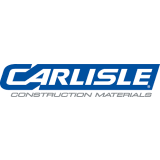This informal CPD article EPDM, Sustainability, and the Environment was provided by CARLISLE Construction Materials, a globally diversified company offering Waterproofing solutions for flat roofs, facades, buildings and landscapes.
Ethylene Propylene Diene Monomer (EPDM)
Ethylene Propylene Diene Monomer (EPDM) membranes are incredibly environmentally friendly and offer a range of benefits for flat roofing, which contributes to sustainability and energy efficiency.
EPDM roof membranes have several environmental friendly benefits, including:
100% Recyclable. Because the EPDM is made from rubber, the sheet of membrane is 100% recyclable after use. Furthermore, it’s becoming more common for tyre manufacturers to donate tyres that are recycled and used to create EPDM.
Durability. Unlike other roofing materials, a roof membrane can last in excess of 50 years. It has minimal maintenance throughout its lifetime. An EPDM flat roof doesn’t degrade, is extremely weatherproof and isn’t prone to moss or algae growing on it.
Recyclable rainwater. Because of the rubber properties and surface, rainwater isn’t polluted by the membrane. This allows the potential to harvest and recycle rainwater using appropriate drainage products.
The International Kyoto Ecology Agreement recognises and recommends EPDM as the best value sustainable, environmentally friendly roofing material available today.
Advantages of Ethylene Propylene Diene Monomer EPDM
EPDM has advantages over other elastomers in that its weathering resistance is extraordinary and its raw materials are highly cost effective. Presently, EPDM dominates the elastomeric roofing market, outselling all other materials combined. Among the single-ply roofing systems, EPDM offers building owners the roofing industry’s longest average service life, with more than 50 years of field performance, representing more than 20 billion square feet installed.
Because EPDM polymer doesn’t contain halogens within the polymer chain and isn’t inherently fire resistant, fire ratings can be achieved through three different avenues: the addition of an external fire retardant, via ballasted roof systems that obviate the need for membrane fire resistance, or through being installed within a defined build up with additional material components.














